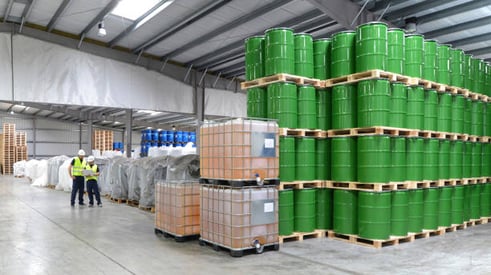
Building Collaborative Supply Chains in Chemical Manufacturing
The Age of Supply Chain Collaboration in Chemical Manufacturing
In the chemical manufacturing landscape, supply chain collaboration is no longer optional—it's imperative. Global disruptions, regulatory challenges, cost pressures, and increasingly complex product formulations have exposed the limitations of isolated planning models. To remain competitive, Production Planners must shift from siloed decision-making to integrated, collaborative supply chain ecosystems.
For Production Planners in chemical manufacturing facilities, fostering collaboration across departments, suppliers, and logistics providers is essential to ensure agile response to demand shifts, efficient resource utilization, and compliance with safety and environmental standards. The convergence of Advanced Planning and Scheduling (APS) systems like PlanetTogether with ERP solutions such as SAP, Oracle, Microsoft Dynamics, Kinaxis, and Aveva provides a strategic foundation to create such connected ecosystems.
This blog explores how collaborative supply chains can redefine efficiency and resilience in chemical manufacturing and how APS-ERP integration empowers planners to lead this transformation.
Understanding Collaborative Supply Chains in the Chemical Industry
Collaborative supply chains in chemical manufacturing refer to a tightly integrated network of internal functions (like production, procurement, R&D) and external partners (such as suppliers, 3PLs, and customers) that share real-time information, risks, and strategic goals.
Key characteristics of collaborative supply chains include:
Real-time data sharing between planning systems and execution platforms
Joint planning and forecasting with upstream and downstream partners
Transparency across the supply chain for proactive decision-making
Alignment of goals for cost optimization, compliance, and service levels
In chemical manufacturing, where production involves hazardous materials, multi-stage processes, and long lead times, such collaboration enhances agility while mitigating risk.
Challenges Faced by Chemical Manufacturing Production Planners
Chemical manufacturing presents unique operational challenges for planners, such as:
Batch size and formulation complexity: Managing product variants and by-products requires detailed planning.
Shelf life constraints: Especially in specialty chemicals, aging inventory may lead to waste or quality degradation.
Regulatory compliance: Planners must ensure traceability and documentation at each production step.
Volatile demand and raw material supply: Many chemical inputs are subject to geopolitical risks, trade tariffs, or natural disasters.
Without real-time coordination, planners struggle to synchronize material availability with production capacity and demand variability.

The Role of Advanced Planning and Scheduling (APS) Tools like PlanetTogether
PlanetTogether's APS capabilities provide production planners with powerful functionality to enable collaborative planning through:
Finite capacity scheduling: Ensures that production is aligned with actual plant capabilities and constraints.
Real-time scenario planning: Helps simulate the impact of supply disruptions or rush orders.
Integration with ERP systems: Enables end-to-end visibility from procurement through production and delivery.
By integrating with platforms such as SAP, Oracle, Microsoft Dynamics, Kinaxis, and Aveva, PlanetTogether facilitates seamless data exchange and harmonized planning processes across the supply chain.

APS + ERP Integration: The Foundation for Collaboration
Integrating APS tools like PlanetTogether with ERP systems allows planners to operate within a collaborative planning ecosystem. Here’s how:
| Functionality |
APS (PlanetTogether) |
ERP (SAP/Oracle/etc.) |
Collaborative Value |
| Capacity Planning |
Dynamic, constraint-based scheduling |
Basic capacity buckets |
Ensures realistic production plans aligned with shop floor capabilities |
| Inventory Visibility |
Real-time consumption and projections |
Static stock levels |
Reduces overstock and stockouts across multiple nodes |
| Procurement Coordination |
Alerts for raw material delays |
Vendor ordering and contracts |
Aligns supply availability with production schedules |
| Logistics Sync |
Load planning and order sequencing |
Shipment tracking |
Minimizes lead times and transportation costs |
Example: A Production Planner at a specialty chemicals firm uses PlanetTogether to simulate a production plan change due to a raw material delay flagged in SAP. The new plan, aligned with capacity and customer SLAs, is pushed back into SAP for purchasing and logistics to respond immediately.
Collaboration Across Stakeholders
Procurement Teams
By integrating PlanetTogether with the ERP, procurement teams can receive accurate material requirements in real time based on changing production plans. This allows for timely ordering, minimizing buffer stock and holding costs.
Sales and Operations Planning (S&OP)
Production Planners play a pivotal role in S&OP processes. With APS-ERP integration, they can provide updated capacity insights and feasible schedules that align with demand forecasts.
Quality and Compliance Teams
Through real-time visibility into production schedules, compliance teams can better plan audits and ensure documentation requirements are met without disrupting operations.
Customers and Suppliers
Via shared planning portals or EDI integrations, suppliers can be notified of changes in material needs, and customers can receive accurate delivery estimates, enhancing trust and service quality.
The Production Planner as a Strategic Collaborator
In an era where supply chain disruptions can ripple across global operations, Production Planners in chemical manufacturing must become strategic orchestrators of collaboration. By integrating PlanetTogether with ERP systems like SAP, Oracle, Microsoft Dynamics, Kinaxis, or Aveva, planners can unlock powerful synergies between production, procurement, logistics, and compliance.
The result is a supply chain that is not just connected—but collaborative, responsive, and resilient.
As the chemical manufacturing industry continues to evolve, Production Planners equipped with advanced tools and collaborative mindsets will be at the forefront of driving operational excellence, sustainable growth, and competitive differentiation.
Ready to make your chemical manufacturing supply chain more collaborative? Discover how PlanetTogether integrates with your ERP to transform planning into a strategic advantage. Reach out today for a demo tailored to your production needs.


